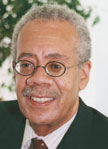|

The
Noblest Roman of Them All: Dean Stanford Roman
By
Jacob M. Appel
An
old joke tells aspiring high school students how to gain admission
to medical school: have parents with high SAT scores. If a great
number of the physicians in New York City are the children and
grandchildren of physicians–
including, incidentally, the majority of medical school deans–then
Dean Stanford Roman of the Sophie Davis School of Biomedical Education
at City College is certainly the “eclectic educator” among the
directors of the city’s medical schools. His seven year combined
BS-MD program recruits minority high school students, often the
first in their family to attend college, and educates a high proportion
of them to become primary care physicians in under-served communities.
It is the only program of its kind in New York state.
“Our
greatest challenge is to identify students who will succeed at
Sophie Davis,” explained Roman. “We’re selecting students straight
from high school so obviously we don’t have the amount of data
the other schools do. And of course our students don’t have the
maturity of recent college graduates. We’re forced to make decisions
based upon potential. We try to ask ourselves how mature a student
will be in two years or six years.” He added that the school receives
more than six hundred applications for only sixty positions and
interviews approximately one hundred students each year. “We do
find the right students,” he said, “but it’s definitely a challenge.”
Students admitted to Sophie Davis spend their first five years
on the Hamilton Heights campus of City College where they acquire
a broad liberal arts education while also studying the basic sciences.
They then relocate to one of seven New York area medical schools
for their final two years of clinical training. Efforts are being
made to expand the students’ clinical exposure so that even those
students in their first few years have some access to patients
and obtain a basic understanding of the daily practice of the
field to which they are to devote their lives.
“Most
of our students stay in the community and most stay in primary
care,” noted Roman. He then added with a grin and a shrug: “We
do have our share of plastic surgeons and neurosurgeons, of course.”
The truth of the matter is that 80% of Sophie Davis graduates
remain in New York and 75% enter traditional primary care fields.
Since a City College medical education is in a sense subsidized
by the state, students are required to devote their first two
years of practice to an underprivileged community. Those who do
not must reimburse the state $75,000—which means that nearly all
Sophie Davis graduates participate in the service component of
the program. More than one in three continues to work in an under-served
community throughout their careers.
Roman’s personal history may explain his deep commitment to underprivileged
minority youth. His father, a Jamaican-born cigar roller, worked
his way through City College and the Howard University College
of Dentistry only to discover that the state’s leading professional
organization for dentists refused to admit blacks; undaunted,
the elder Dr. Roman founded his own. Dean Roman discovered early
on that he loved school and although he studied psychology in
college, he quickly realized that medical school offered a gateway
to a profession both interesting and useful. Without his father’s
obstacles to professional advancement, he attended Dartmouth and
Columbia College of Physicians and Surgeons. In the summer between
his first and second years of medical school, he helped conduct
a study on the attitudes of recent mothers toward birth control
that demonstrated widespread acceptance of contraception and led
the New York State Department of Health to liberalize its approach
to the subject. During his third year he was among several students
who helped found a program in Central Harlem that offered free
basic medical check-ups to schoolchildren. “Many of these kids
had treatable disorders: deteriorating vision, sickle-cell disease.
We were screening them for the first time,” explained Roman. “That’s
when I learned that a doctor can make a difference in the community.”
Education Update, Inc., P.O. Box 20005, New York, NY 10001. Tel:
(212) 481-5519. Fax: (212) 481-3919. Email: ednews1@aol.com.
All material is copyrighted and may not be printed without express consent of
the publisher. © 2001.
|

